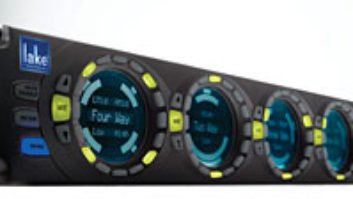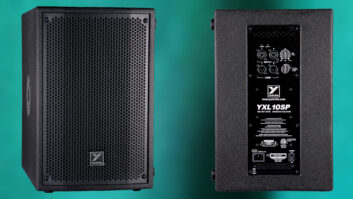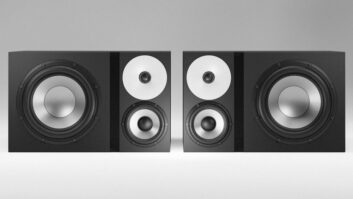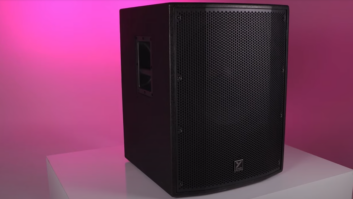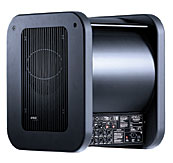
Field Test: Genelec 7070A Active Subwoofer
Apr 1, 2004 12:00 PM,
By George Petersen
Custom Low-End Control for Nearly Any Environment
When Genelec introduced its 7000 Series of active subwoofers, I was intrigued by these systems, which not only provide solid, below 20Hz LF reproduction, but also offer 6.1 bass-management capability and flexible acoustical tweaks to make the system work in nearly any listening space.
Designed to remove the acoustical nonlinearities from port turbulence, Genelec’s Laminar Spiral Enclosure™ technology used in the 7070A creates a bass reflex cabinet made of a thick piece of sheet metal rolled into a spiral shape and clamped between 2-inch-thick MDF slab side panels. This creates a very long reflex tube in the smallest possible enclosure by combining a front-firing woofer with a large side-exit port. This design results in an extremely rigid enclosure, with heavy steel rods linking the front and rear baffles into a cabinet that’s strong and almost entirely nonvibrational and free of unwanted resonance. As an added plus, the rods double as handles for moving the sub.
The 7070A is the middle of the 7000 Series, with a 12-inch woofer driven by a 250-watt amp. The 7070A could be used with any speakers but was designed to be used with Genelec’s 1031A, 1032A and S30D models. The system includes bass management for a 5.1 or 6.1 system, with six signal input and output channels (L/C/R front and L/C/R rear), as well as a dedicated LFE input. All audio connections are balanced XLRs. The onboard bass-management circuitry divides the six (or five) main channel inputs into LF and HF components, which route to the sub and main speakers at a fixed 85Hz crossover.
One of the system’s strongest points is the flexibility and control it offers in allowing users to tweak parameters to match any listening environment. The sensitivity of the lowpass section has a +12 to -6dB adjustment for level-matching the sub to the mains. The dedicated LFE input can set to 0dB or +10dB sensitivity and two bandwidths: 18 to 85 Hz or 18 to 120 Hz. A selectable Redirect function routes the frequencies above 85 Hz in the LFE signal to the center-channel monitor. Also provided are a phase response switch with settings (0/90/180/270°) at 85 Hz; a calibrated bass roll-off, attenuating subsonic (below 20Hz) response in 2dB steps; and a sum-in connection for cascading multiple subwoofers for even coverage in very large spaces or high-SPL applications.
Three optional remote units are available. One is a switch that connects to a ¼-inch jack, bypassing the subwoofer/bass-management functions; another is a bi-color LED indicating power on and signal clipping conditions; and the third combines the functions of Bypass and the +10dB gain LFE switching.
IN THE STUDIO
Once I had this 25×22×20-inch, 110-pound beast unpacked, I combined the 7070A with a pair of Genelec S30Ds full-range, three-way monitors that feature both digital and analog inputs. In this 2.1 install in a control room that was 18×11 feet with an 8-foot ceiling (about 1,600 cubic feet), the combination was almost too much until I took the sub way down. In a smaller project room like this, the S30Ds actually provided plenty of bass on their own, and a system such as Genelec’s 10-inch 7060A or 7050A sub matched with smaller 1029A, 2029A or 2029B mains would have been more appropriate. So I moved to a larger space, a 17×15 room with a 12-foot ceiling (3,060 cubic feet), and the 7070A/S30D combination seemed right at home.
With all of the tweaks on the 7070A, the system can be precisely set for flat response without resorting to external equalization. One nice touch is the sub’s built-in 85Hz tone generator, so adjusting the system phase requires little more than a simple SPL meter. Also helpful is the well-written manual, which goes into detail about the setup/calibration procedure. The 7070A controls are mounted on the side, making for fast adjustments without having to dig behind the unit to move a DIP switch. The best results came from experimenting with subwoofer placement, moving it toward (or away from) wall surfaces and corners to find a close-to-optimum position and then tweaking the electronics. However, in some installs, sub placement can be restricted or limited, and in such cases, the 7070A’s phase, roll-off and sensitivity adjustments really make a difference.
The S30Ds offer ruler-flat, wide-bandwidth response with Genelec’s proprietary ribbon tweeter taking the upper end out to 50 kHz. The low end goes down to an impressive 36 Hz (-2.5 dB), which is great for an 8-inch woofer. But combined with the 7070A, the system jumps. The difference is dramatic and immediate; it’s one of those cases where you thought everything was fine and then once you’ve the heard the change, you never want to go back. A subwoofer will add an octave or two to a system’s overall response, but what I heard with the 7070A was light years removed from simply adding more bass.
The 7070A’s ability to reproduce bass transients is uncanny, and the effect is hearing a system that’s several times larger than what the sub’s compact enclosure would indicate. Also, large bass horns are not typically known for their articulation and definition, but I clearly heard these with the 7070As on just about any type of program material — from hip hop to pipe organ — without any discernable distortion. The sub-to-top transition was seamless, and the bass was smooth, natural and never forced-sounding. And with peak SPL capability in the 117dB range, bass reproduction became something you could feel. Wheeeeew!
As an adjunct to making great monitors sound even more over the top (or bottom), it’s hard to imagine a better upgrade than Genelec’s 7000 Series subs. Users can always begin their system by adding a 7070A to a stereo pair — as I did — and then be ready for the hyperspace leap to 5.1 or 6.1, making this system one smart investment.
Genelec, 508/652-0900, fax: 508/652-0909, www.genelec.com.
<<<<<<<<<<<<<<<<<< PAGE BREAK >>>>>>>>>>>>>>>>>>
